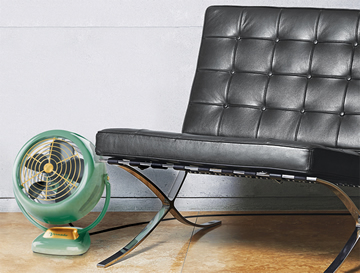Revival of the Coolest
 |
|
|
Few products are more functionally or visually suited for a mid-century modern home than the VFAN, made by the Vornado Air company. And none have a more tangled history.
To Brian Cartwright, the Vornado is a truly iconic American invention, one he likens to the Converse One Star sneaker, the KitchenAid mixer, and the Fender Stratocaster guitar for its near perfection from the moment of conception.
Just when that conception occurred—and who was responsible—are topics of some debate, which Cartwright, Vornado Air's Director of Brand and Design, learned after joining the company in 2009.
"It's a bit of an archeology project," Cartwright says. "In terms of storytelling, you can't make these things up. It's like I won the lottery of storytelling."
The story begins on the cusp of the Great Depression in Oklahoma, 1929, where Ralph Odor, a fledgling designer and inventor, test-flies a model plane with uniquely intubed propellers. The model had a wingspan of four feet and was tethered to a pole. When he began his research, Cartwright admits, "I did not know that there was this 'actor,' Ralph K. Odor, involved."
To jump ahead a bit, the iconic, intubed Vornado fans were built by the Kansas-based O.A. Sutton Co. from 1945 into the 1950s, when the company reportedly went bankrupt. The product name was based on the unique 'power vortex' action, similar to a hurricane or tornado, created by its revolutionary design.
 |
|
|
The brand went idle for three decades, until entrepreneur Michael Coup undertook its resurrection in the late '80s. That's where the story gets murky.
"In my role as the kind of steward of our brand, I'm very aware of what people are saying about us online," explains Cartwright. It was through this other great invention, the Internet, where he came across "an eye-opening look at a history I didn't know existed."
Through the web site vornadotrust.com, Cartwright first learned of Odor's work in the 1920s, '30s, and '40s on creating mechanical vortices and his role in launching the Vornado.
The site is written and researched mostly or entirely by a grandson of Odor's, Don Morris, who inherited his grandfather's books, articles, photographs, and documentation. When Morris learned that a more famous industrial designer, Richard Ten Eyck, was being credited with inventing the Vornado, he set to work with a proud grandson's zeal.
Ten Eyck's distinguished career included being on the design teams of numerous important American aircraft as well as tractors, Westinghouse air conditioners, and other products. He is credited by some with designing the Vornado, based in part on a 1949 drawing and interviews he gave during his retirement.
"I'm trying to parse out where all these lines cross," Cartwright says of his challenge.
At vornadotrust.com, which is not affiliated with Vornado Air, Morris lays out a...




